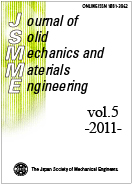All issues
Volume 5, Issue 4
Displaying 1-3 of 3 articles from this issue
- |<
- <
- 1
- >
- >|
Papers
-
Masahiro NISHIDA, Junji NAGAMATSU, Koichi TANAKA2011Volume 5Issue 4 Pages 164-178
Published: 2011
Released on J-STAGE: April 28, 2011
JOURNAL FREE ACCESSThe dynamic behavior of granular media subjected to projectile impact was numerically investigated using a discrete element method (DEM). Specifically, the effects of the impact angle on the dynamic phenomena of projectile and granular media were examined. In general, after impact, a projectile either penetrates, rebounds, or moves horizontally depending on the impact angle of the projectile. The velocity histories of projectiles after impact for penetration and rebound differed. The impact angle did not affect drag force histories. The drag force histories of projectiles had ƒ-0.4 and ƒ-2.7 spectra. We have presented the probability distribution of the scattered velocity of granular media. When projectiles rebounded from granular media, the angle distribution of scattered granular media in the horizontal plane was butterfly-like. The impact angle did not affect the angle distribution of scattered granular media in the vertical plane. The granular media scattered in an elevation angle region of 40-60° regardless of the impact angle.View full abstractDownload PDF (711K) -
(TEM and EBSD Observation Corresponding to Fractography)Hide-aki NISHIKAWA, Yasuji ODA, Yoshimasa TAKAHASHI, Hiroshi NOGUCHI2011Volume 5Issue 4 Pages 179-190
Published: 2011
Released on J-STAGE: April 28, 2011
JOURNAL FREE ACCESSObservations by Transmission Electron Microscopy and Electron Backscatter Diffraction corresponding to Fractography were conducted in order to investigate the brittle-striation formation mechanism of low carbon steel JIS S10C in a hydrogen gas environment. The main results are as follows: (1) The quasi-cleavage (QC) facets plane with brittle-striations does not coincide with the (100) cleavage plane. (2) Slip deformation distributions reflecting the brittle-striation formation processes are observed by TEM. One of the conceivable brittle-striation formation mechanisms which can explain these results is as follows. A striation line is formed during the loading part of the cycle as a trace of blunting by slips. A stable ductile crack then starts growing. These processes are similar to those in the normal ductile fracture from a crack; that is, a ductile tearing process in tension.View full abstractDownload PDF (3137K) -
(2nd Report, Proposal for Judgment of Crack Interference and Correction Methods of Crack- Shape)To-ru ARAMAKI, Shigeru HAMADA, Hiroshi NOGUCHI, Shinya MIYAJI, Toshihi ...2011Volume 5Issue 4 Pages 191-208
Published: 2011
Released on J-STAGE: April 28, 2011
JOURNAL FREE ACCESSThe alumina spray coating is a material containing many pores (cracks) and there is a crack-interference in the alumina spray coating, therefore, the crack-interference leads to a decrease in the fracture strength. There are some studies that have used the elastic analysis for two or more cracks. Moreover, there are some standards for the combining of the cracks. However, in ceramics including alumina, a study of quantifying the internal spread of the crack when interfering and presuming a static fracture strength with judgment of the crack-interference after the stable crack propagation is not known. In this study, after the alumina spray coating single layer was taken out, a Vickers' indentation crack was introduced, a 4-point bending test was performed and a R-curve was acquired. As a result, the fracture strength characteristic of the alumina spray coating single layer was clarified. Three judgments of the crack-interference with the R-curve were then proposed. Moreover, a correction method of the crack-shape when the cracks interfere was proposed. The validities of the proposals were verified with bending tests after two Vickers' indentation cracks were introduced.View full abstractDownload PDF (1622K)
- |<
- <
- 1
- >
- >|
